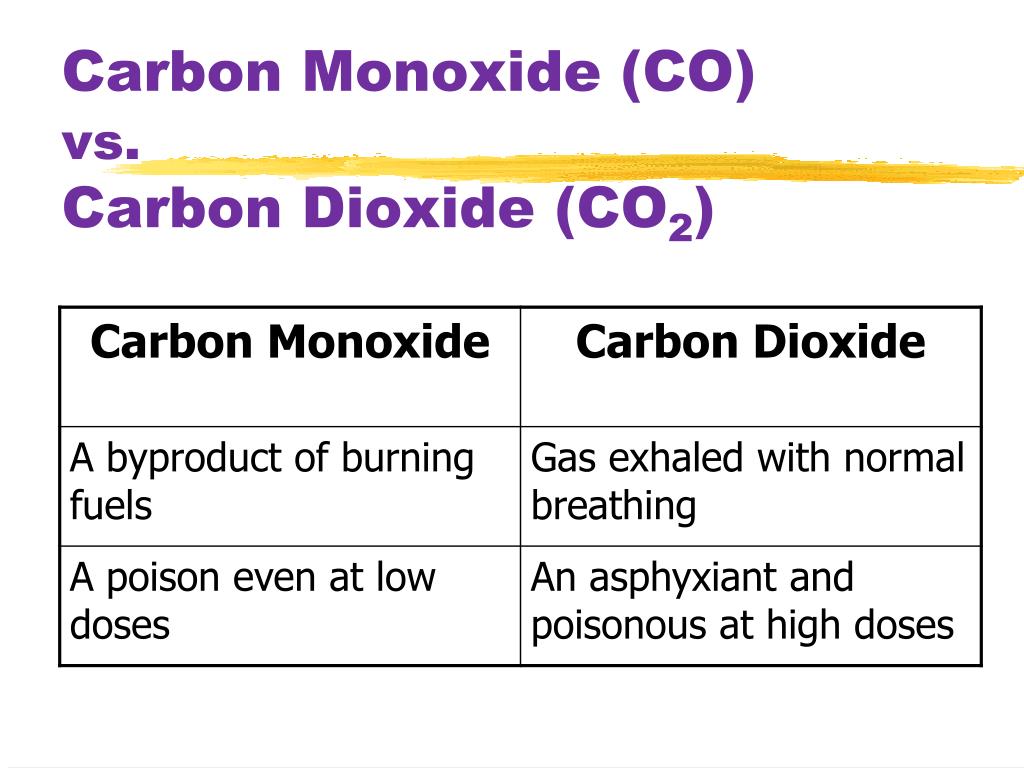

- #Carbon monoxide vs carbon dioxide how to#
- #Carbon monoxide vs carbon dioxide generator#
What are other ways to heat my home this winter?Ĭheck out these websites for tips on how to keep warm and safe this winter: If you use this type of heater, consider installing a carbon monoxide detector alarm. Only use approved indoor heaters inside for warmth and have them serviced at least every 2 years by a registered gas fitter.Only use fuel-powered appliances (such as pressure washers or concrete saws) outside, or in well ventilated spaces.Do not leave your car running in the garage (even when the garage door is open).
#Carbon monoxide vs carbon dioxide generator#
Only use generators outside and make sure the generator is not near a window or door and is pointed away from the house. They can produce carbon monoxide even if there is no smoke. Only use barbeques, charcoal briquettes/beads or grills, outdoor heaters or gas lanterns outside. How do I prevent carbon monoxide poisoning? people with chronic medical problems, like heart disease. Who is at risk?Ĭarbon monoxide poisoning can affect anyone. Symptoms of carbon monoxide poisoning gradually get worse the longer you breath in the gas. What are the symptoms of carbon monoxide poisoning? tools with gasoline engines (such as pressure washers or concrete saws). barbeques, charcoal briquettes/beads and grills. What are the common sources of carbon monoxide?Ĭommon sources of carbon monoxide include: When does carbon monoxide poisoning occur?Ĭarbon monoxide poisoning often occurs when people use outdoor devices indoors or in a closed space without enough air flow. Some devices make carbon monoxide and should never be used indoors, including outdoor heaters and barbeques, tools with gasoline engines and vehicle engines. It is produced from burning fuels like gas, wood and charcoal, even if there is no smoke. However, these critical hemodynamic and metabolic variables recovered to baseline values by 15 min after stopping the CN infusion, except lactic acidosis which persisted for at least 25 min after the CN infusion.Carbon monoxide is a poisonous gas that you can’t see, taste or smell. Compared to baseline values, CN caused significant (P < 0.01) decreases in cardiac output (6.4 +/- 2.0 to 3.1 +/- 0.5 L/min) and heart rate (169 +/- 44 to 115 +/- 29 bpm) and decreases in oxygen consumption (VO2) (133 +/- 19 to 69 +/- 21 mL/min) and carbon dioxide production (VCO2) (128 +/- 27 to 103 +/- 22 mL/min). On the other hand, CN severely depressed most hemodynamic and metabolic functions. Despite significant CO poisoning (peak carboxyhemoglobin fractions = 46% of total hemoglobin elimination t1/2 = 114 +/- 42 min) with attendant decrease in blood O2 content, CO had essentially little effect on any hemodynamic or metabolic variable. 
Cardiorespiratory measurements were conducted before and after these toxic challenges. Then, potassium CN was intravenously (i.v.) infused (0.072 mg.kg-1.min-1) for 17.5 +/- 3.0 min. In seven dogs (24 +/- 3 kg), CO gas (201 +/- 43 mL) was administered by closed-circuit inhalation. To examine the indication for treatment of CN toxicity, we have established a canine model to delineate the natural history of combined CO and CN poisoning.

Oxygen therapy is the specific treatment for CO poisoning, but the treatment of CN toxicity is controversial. During fires, victims can inhale significant carbon monoxide (CO) and cyanide (CN) gases, which may cause synergistic toxicity in humans.







 0 kommentar(er)
0 kommentar(er)
